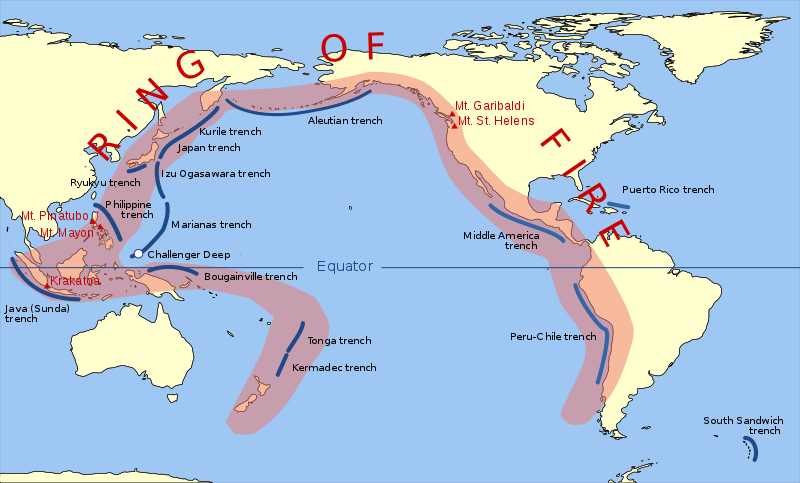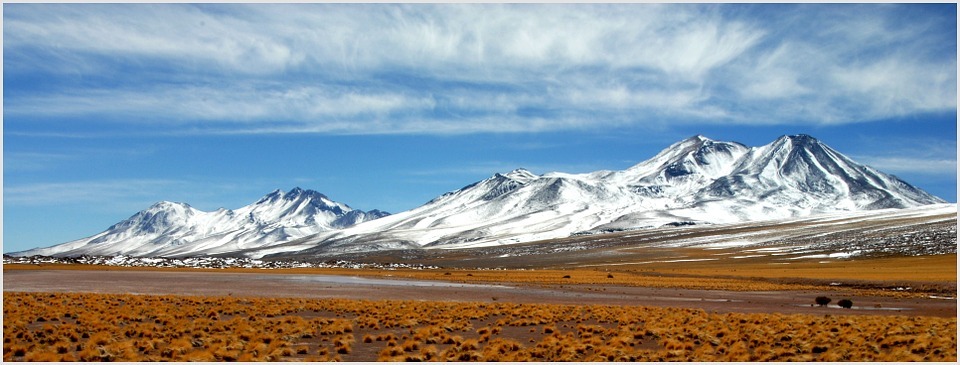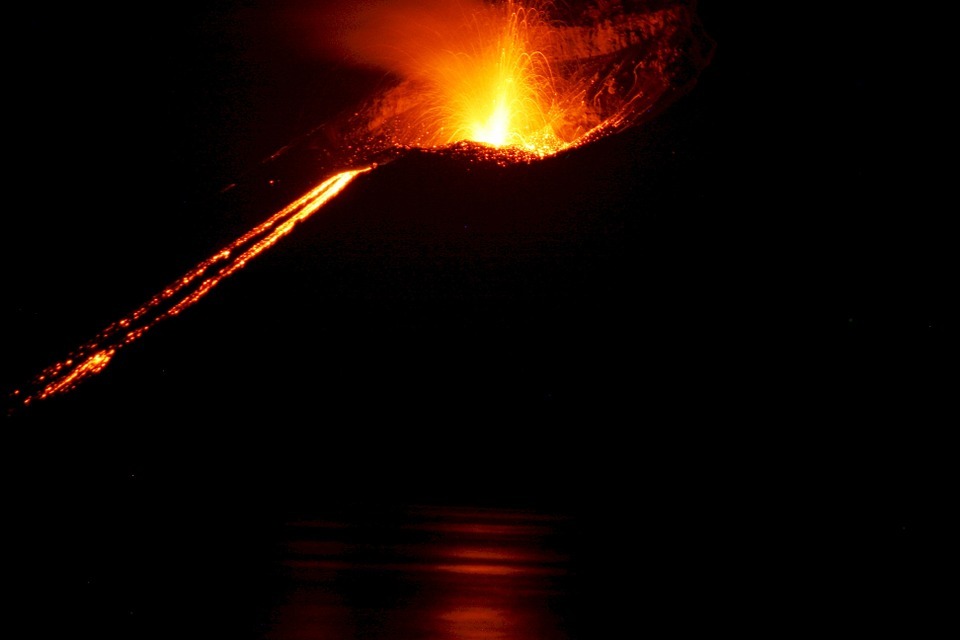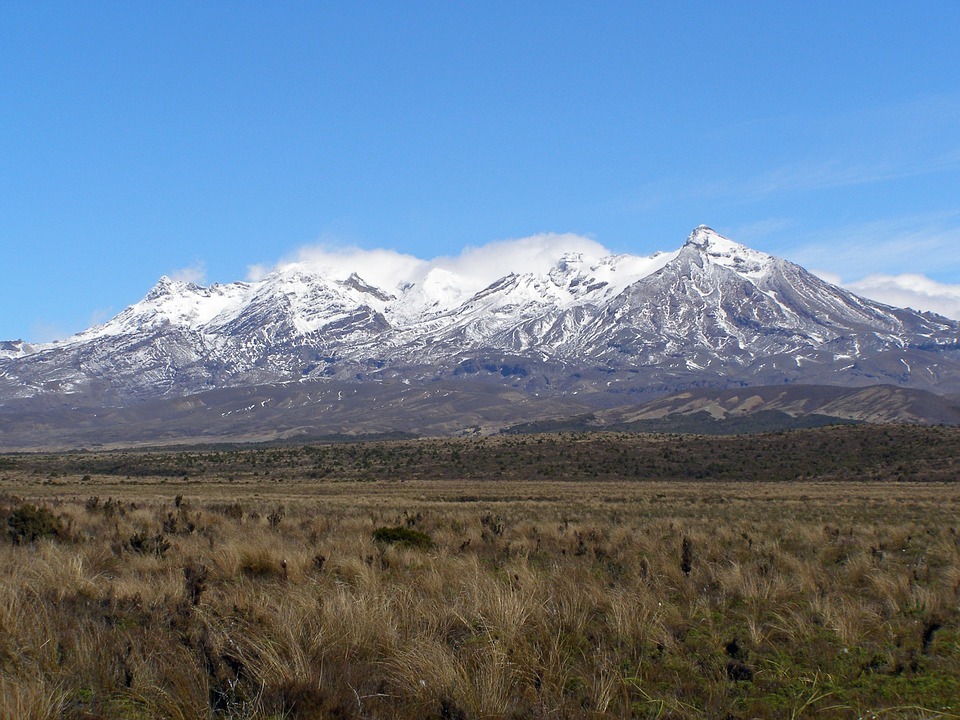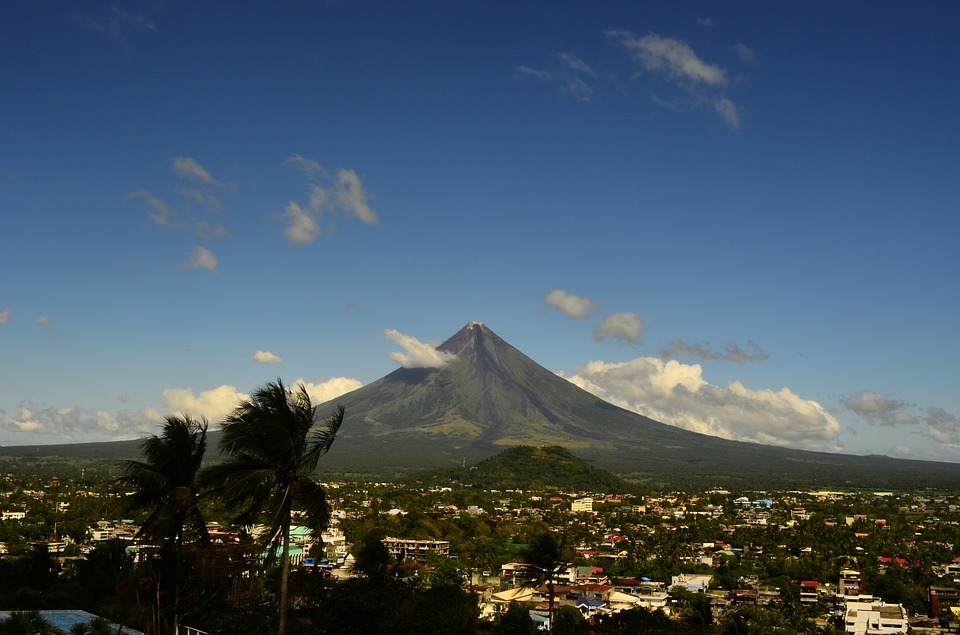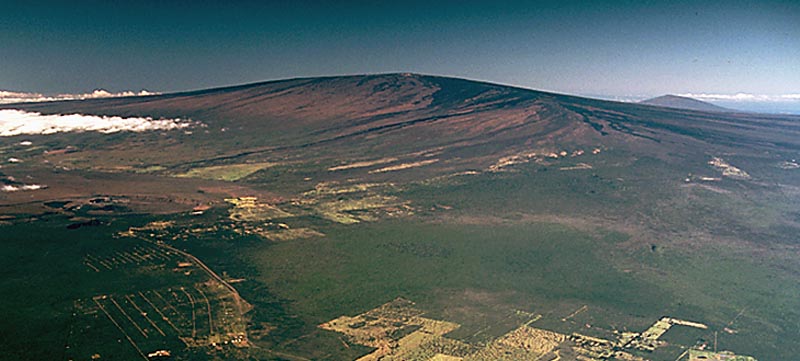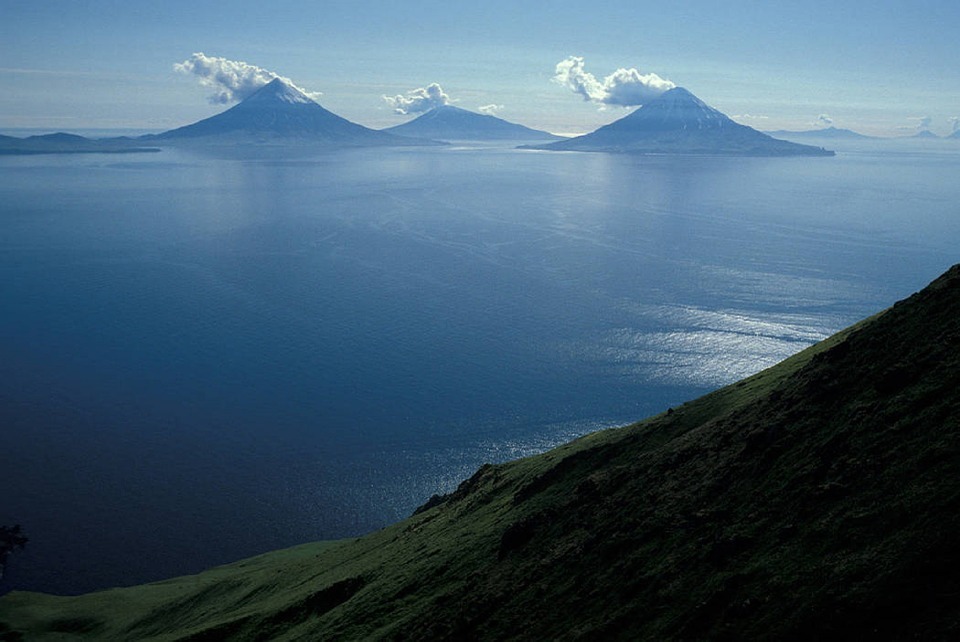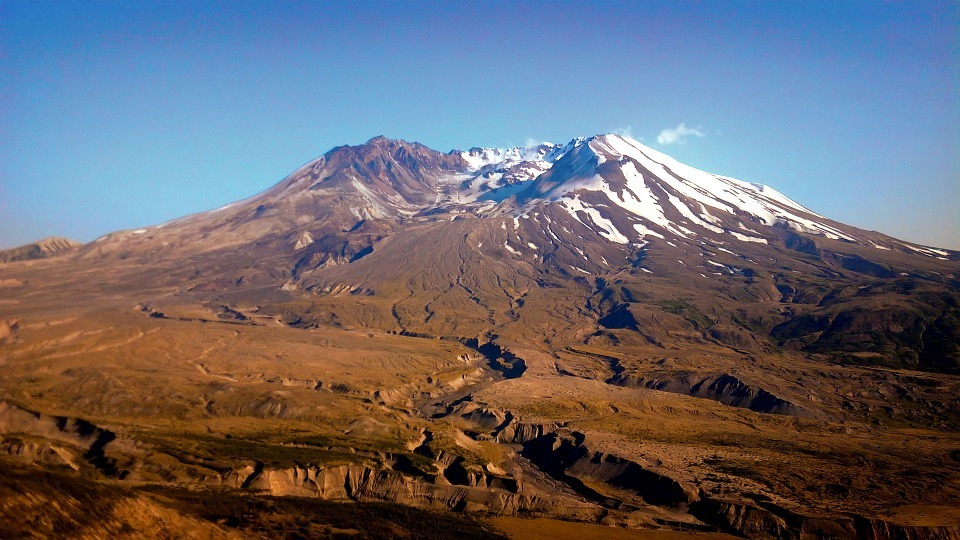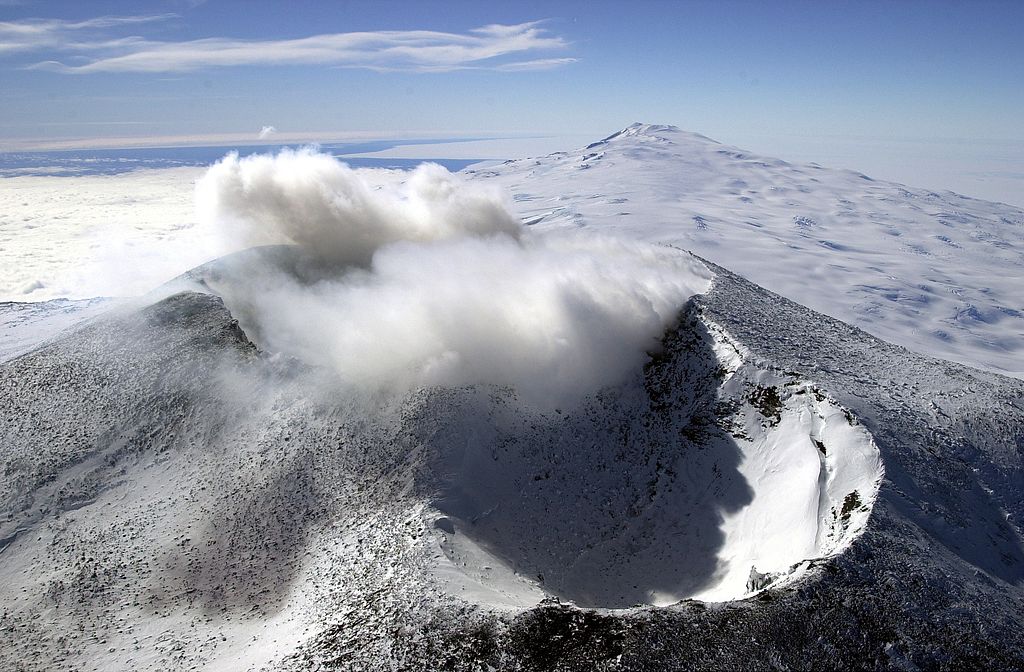The Ring of Fire or sometimes called the circum-Pacific belt is composed of a long chain of volcanoes and other tectonically active structures surrounding the Pacific Ocean. It is one of the most geologically active areas on Earth and is a place for frequent earthquakes and powerful volcanic eruptions. The long chain of volcanoes run up along the western coast of South and North America crosses over the Aleutian Islands in Alaska, runs down the eastern coast of Asia past New Zealand going into the northern coast of Antarctica.
Interesting Facts about the Ring of Fire
There are 452 active and dormant volcanoes within the Ring of Fire and many of them were created through the tectonic process of subduction which happens when dense ocean plates collide with and slide under the lighter continental plates. As the melted material or magma from the ocean floor enters the Earth’s interior, it rises to the nearby surface as lava which forms volcanoes.
About 90 percent of the world’s earthquakes and 81 percent of the world’s largest earthquakes occur along the Ring of Fire. In fact, all but three of the 25 largest volcanic eruptions in the world in the last 11,700 years occurred at volcanoes in the Ring of Fire.
The Ring of Fire is also home to the Mariana Trench which is the deepest ocean trench. It is located on the east of Guam. The Mariana Trench is 7 miles deep and was formed when one tectonic plate was pushed under another.
Major Volcanoes Along the Ring of Fire
Out of the 452 volcanoes found along the Ring of Fire, here are the major, most active, and most dangerous ones:
1. Mt. Fuji
Mt. Fuji is located on the Japanese island of Honshu and is at 12,380 feet or 3776 meters. It is the tallest mountain in Japan and also the world’s most visited mountain. It is considered as the Empire of the Sun’s most notable landmark. But more than being a mountain, Mt. Fuji is an active volcano and its last eruption was in 1707. Based on some scientists, they are concerned that a large earthquake might trigger the mountain into a spectacular and deadly blast.
2. The Andes
The Andes Mountains run 5,500 miles or 8,900 kilometers north and south along the western edge of South America. They are considered the longest continental mountain range in the world. Within this mountain range is the Andean Volcanic Belt which is broken up into four volcanic zones including active volcanoes such as Cotopaxi and Cerro Azul. Aside from that, it is also home to the highest, active volcano which is the Ojos del Salado.
3. Popocatepetl
This is an active volcano in the Trans-Mexican Volcanic Belt. It is located near Mexico City and is considered by a lot of people to be the most dangerous volcano in the world because a large eruption of this volcano can potentially kill millions of people.
4. Krakatoa
Krakatoa is located in the Indonesian Island Arc. It is famous for its massive eruption that occurred on August 27, 1883, which killed 36,000 people. That eruption was also heard 2,800 miles away and is considered to be the loudest sound in modern history. Aside from Krakatoa, the Indonesian Island Arc is also home to Mt. Tambora which erupted on April 10, 1815. Its eruption was the largest in major history and was calculated as a 7 on the Volcanic Explosion Index.
5. Mount Ruapehu
Mt. Ruapehu is the tallest mountain on the North Island of New Zealand rising to 9,177 feet or 2797 meters. It is located in the southern section of the Taupo Volcanic Zone and is considered to be New Zealand’s most active volcano.
6. Sakurajima
This is another volcano in Japan that is very active. In fact, it has erupted many times in the last hundred years. Its most notable eruption was in 1914 where large lave field flowed down the side of the volcanic cone. It had created new land masses which connected the island to the mainland. If it will have a large eruption today, it might put the city of Kagoshima in serious jeopardy.
7. Taal
The Philippines is also a home to a lot of volcanoes and the scariest is probably Taal which is located in a large lake. Taal volcano is situated on the main island of Luzon which is near some substantial urban areas. If it will erupt in the near future, its lava might mix with the lake water, creating an even more massive and deadly explosion.
8. Mayon
Mayon volcano is another active volcano located in Albay, Philippines. It lies next to the Gulf of Albay which is a heavily populated area as well. Therefore, eruptions from Mayon have to be watched carefully especially that the volcano has been very active in the 21st century.
9. Santa Maria
The Santa Maria volcano is located in the western Guatemalan highlands near the city of Quetzaltenango. It erupted violently in 1902 and killed at least 5,000 people. Ever since that eruption, much minor activity has occurred but nothing that has harmed the local population has happened. However, it should still be watched closely because another major volcanic event could occur at any time.
10. Merapi
This volcano is located in the center of a large island called Java in Indonesia. The name Merapi means Mountain of Fire. It has erupted more than 80 times. In 2010, it burst into flames which killed 350 people and left hundreds of thousands homeless.
11. Mauna Loa
Mauna Loa is considered to be the most dangerous volcano on the main island of Hawaii. It can be found close to the city of Hilo. Hawaiian volcanoes are known to produce large creeping masses of hot lave and numerous fissures in the landscape and sometimes, they also emit poisonous sulfur gases.
12. Galeras
Galeras volcano is located in Columbia. It is considered one of the most dangerous volcanoes in the region. In the past fifty years, it had numerous small to medium sized eruptions. It is situated along a large nearby urban area of Pasto and if it erupts again, it can create a dire situation in the nearby city.
13. Aleutian Islands
The Aleutian Islands in Alaska is composed of 12 large and 55 small islands which are all made from volcanic activity. There are 52 volcanoes on this island and some of the most active ones are Cleveland, Okmok, and Akutan.
14. Mt. Saint Helens
Mt. Saint Helens is located on the Cascade Mountains in the United States’ Pacific Northwest which hosts an 800-mile Cascade Volcanic Arc. This volcanic arc contains 13 volcanoes and about 3,000 other volcanic features. Mt. Saint Helen’s most recent eruption occurred in 1980 and it was the most significant to occur in the contiguous 48 US states in recorded history.
15. Mount Erebus
Mount Erebus is the most well-known volcano in Antarctica and is also the world’s southernmost active volcano. It is located on Ross Island where three inactive volcanoes are situated namely, Mount Terror, Mount Bird, and Mount Terra Nova. Mount Erebus is the second-highest volcano in Antarctica and the sixth-highest ultra-mountain on an island with a summit elevation of 12, 448 feet or 3,794 meters. It has been observed to be continuously active since 1972.
Even though there are high levels of volcanic and seismic activity on the Ring of Fire, there are still millions of people that live among its breathtaking landscapes. This is why scientists and governments are looking for ways on how they can help the nations in the region improve their response to natural disasters and build their resiliency.

